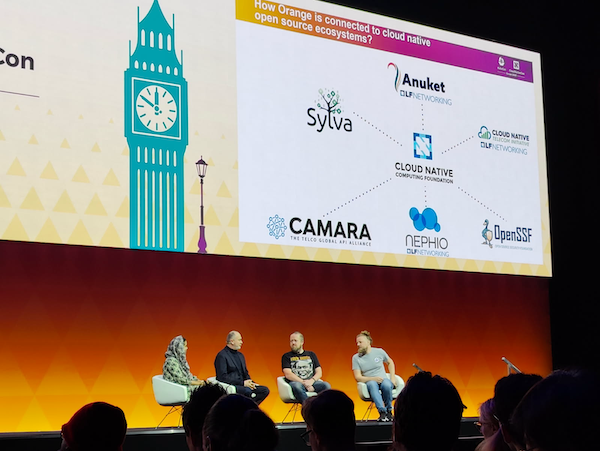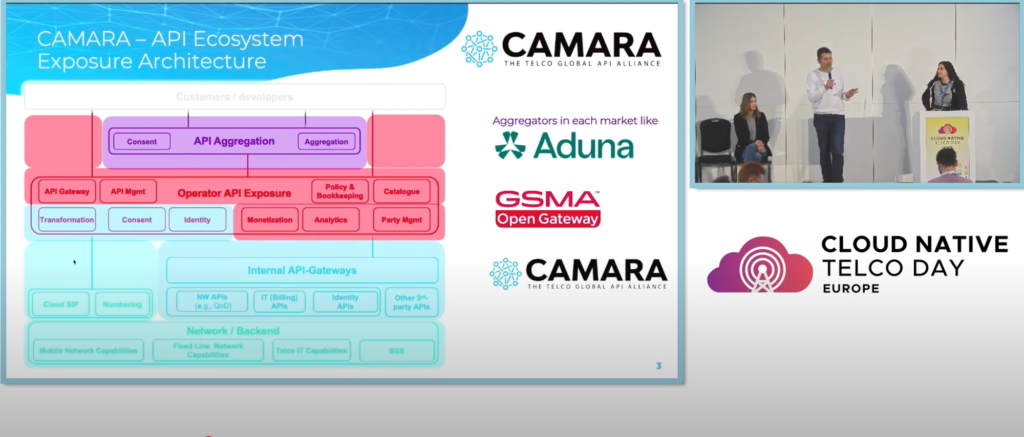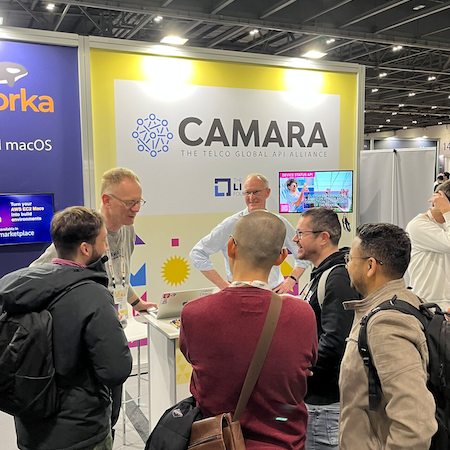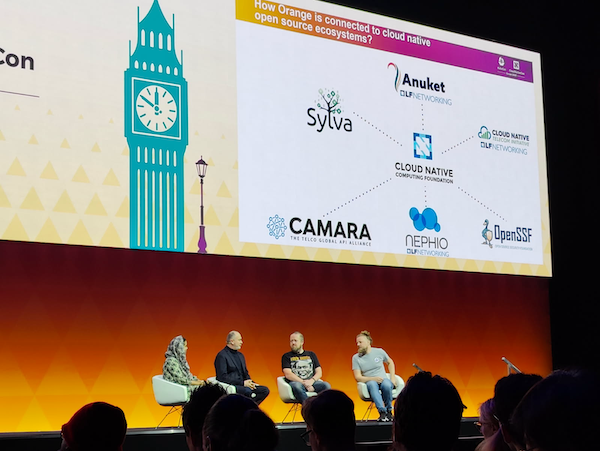Unlocking premium services at KubeCon: how Telco APIs empower developers
Published: April 4, 2025

With the Telco API at KubeCon, telecom operators are giving developers the super power to take their services to the premium level!
The telecommunications industry is undergoing a transformation, driven by the demand for scalable, cloud-native solutions that integrate advanced networking capabilities with modern applications. CAMARA, an open source project under the Linux Foundation, aims to standardise APIs and simplify access to telco capabilities.
KubeCon + CloudNativeCon Europe: a gathering of innovators
KubeCon + CloudNativeCon Europe, organised by the Cloud Native Computing Foundation, is the largest gathering of the cloud-native ecosystem, attracting over 12,000 developers, architects, DevOps professionals and experts to London. These attendees are using cloud-native technologies to improve their businesses and provide tools for production-ready services and applications. With CAMARA at KubeCon, the telco industry is among its number one target: developers and tech ecosystem!
Highlights from Cloud Native Telco Day
Let’s delve into the key learnings from Camara and the Telco API perspective after a week at KubeCon Europe in London.

The week kicked off with the Cloud Native Telco Day, a co-located event at KubeCon, held the day before the main conference. This event aimed to unite the networking and cloud-native open-source communities, fostering collaboration among telecom operators, vendors, and cloud service providers to share insights and innovative concepts.
For the first time, the agenda included a dedicated session on Telco APIs, spotlighting the Camara project. The presentation, titled “Unlocking Telco Innovation: Bridging the Gap Between Telcos and (Cloud) Developers,” was delivered by Markus Kummerle (Deutsche Telekom), Laura Lacarra (Telefonica), and Jill Lovato (The Linux Foundation) to an audience of over 300 participants. The speakers highlighted CAMARA’s mission to enhance collaboration among telcos, developers, and hyperscalers. They emphasized the project’s value in simplifying the complexities of telco networks through APIs, making them accessible across different networks and countries. Concrete examples were provided, including Simple Edge Discovery, Application Endpoint Discovery, Energy Footprint Notification, and Traffic Influence, and showcasing how cloud capabilities are being leveraged to implement these APIs.
CAMARA booth experience

S753. This was the reference of the CAMARA booth in the Solution Showcase floor. During three days, friendly community members from Deutsche Telekom, Telefonica and Linux Foundation took turns to welcome, inform, present CAMARA Spring25 Meta-Release, and also shared API video demos from T-Mobile and Verizon. Discussions started with almost the same path:
- What are the main use cases with Telco APIs?
- How the ecosystem is structured?
When mixing the different discussions, the use cases sharing bring scenarios leveraging identity, anti fraud, frictionless digital onboarding, quality on demand and slices.
On the ecosystem side, it was an incredible opportunity to clearly explain how CAMARA, GSMA OpenGateway and Aduna interelate, focused on standardizing and simplifying access to telecommunications capabilities through APIs. CAMARA aims to create open source APIs that enhance collaboration between telcos and developers, facilitating the integration of network services into applications. GSMA’s OpenGateway complements this by providing a framework for telcos to expose their capabilities as APIs, promoting interoperability across different networks. Aduna, a platform designed to streamline the development and deployment of telecom APIs, offers tools and resources that support developers in leveraging these APIs effectively. Together, these initiatives foster a cohesive ecosystem that drives innovation and accelerates the adoption of cloud-native solutions in the telecommunications industry. The major goal of being present at KubeCon for CAMARA has been reached giving a true opportunity to explain, advocate and give meaning on Telco APIs.
Keynote insights: Cloud Native evolution in Telecom
And the last highlight for CAMARA for the 2025 KubeCon episode was during the Friday MainStage keynote with the « Cloud Native evolution in Telecom – 5G, 6G and beyond » session with Faseela K., Philippe Ensarguet, Tom Kivlin and Joel Studler highlighting an overview of the open source ecosystem related to Telco ecosystem.

Learnings from KubeCon: AI and Cloud Native
Finally, impossible to wrap-up this article about the week of KubeCon Europe 2025 without sharing two learnings related to cloud native ecosystem.
The first one is (obviously or … oh no not yet) related to AI. I loved the discussions I’ve got from the AI & Cloud Native Roundtable organized by Linux Foundation Research, the executive Summit organized by CNCF and some keynotes, questioning ourself if the shift that happened with monoliths to microservices workloads will be the same for AI model with LLMs and SLMs, spotted the case for similar services keys in cloud native on security, scheduling, observability, … and I’m feeling we are in a journey where Kubernetes won’t be only the platform hosting AI, but truly becoming the AI runtime with important signals like its capabilities in context-aware request routing, dynamic resource allocation for optimized GPU and TPU usage, intelligent multi-model serving, or enhanced vLLM integration that ensures faster inference and efficient resource utilization, just considering the inference space. To hang on AI, but on the agentic ai side, Model Context Protocol (MCP), « the TCP/IP of AI », was also in the place, and with an interesting announcement of a MCP gateway aiming at discovering, securing, and federating multiple MCP tools and tool servers into a virtualized MCP server. I’m curious to imagine where we will be let’s say in one year at KubeCon Europe 2026 in Amsterdam!
The second point is not new but looks important to my eyes considering API and Cloud Native as the evolution of Kubernetes is highlighted by the transition from Ingress to the Gateway API. Ingress is a resource that centralizes the management of external access to services within a cluster by defining routing rules for HTTP/HTTPS traffic. However, as requirements have evolved, the Gateway API has emerged as its successor, offering advanced features for Layer 4 (L4) and Layer 7 (L7) routing, along with enhanced extensibility and observability. Unlike Ingress, which is now considered legacy and has reached a state of feature freeze, the Gateway API enables more granular traffic management and supports a wider range of protocols. It introduces new resources which facilitate the separation of concerns and improve portability across different implementations. In summary, the Gateway API aims to standardize and enhance traffic management capabilities in Kubernetes, gradually replacing Ingress.
Can’t wait for coming KubeCon 2026 as I’m truly convinced that we are in front of major change at the cross roads of Cloud Native, AI, platforming … and Telco API!

Philippe Ensarguet
VP Software Engineering, Orange
Philippe is a senior technology executive in digital transformations across large corporations and startups. Currently serving as the Vice President of Software Engineering at Orange, he supports the company’s transition from a telecommunications provider to a technology company while scouting for disruptive technologies and partnerships.



